The 1975-76 season was the Kansas City Scouts’ final season of existence as an NHL team in Kansas City, Missouri. The Scouts were initially baptized into the league alongside the Washington Capitals for the 1974-75 season. Excluding 1979 when the NHL held an expansion draft in order to bring aboard four teams as part of a merger agreement with the WHA, the Scouts and the Capitals were the last true expansion teams brought into the league until the San Jose Sharks came along in 1991.
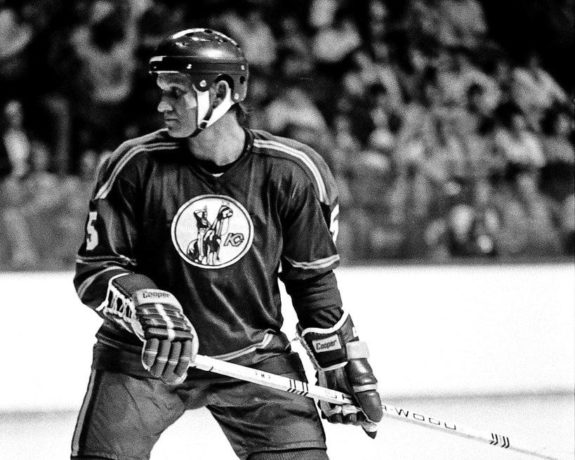
And unlike the Capitals and the Sharks, the Scouts fared miserably in their two lone seasons. Enough so that during the summer of 1976 the team relocated to Colorado to become the Rockies. Even in Colorado the team only managed to remain viable for six seasons before moving to New Jersey where they have remained ever since as the better known and far more renowned Devils.
Part of the reason why the Scouts failed to gain attention and build a winning team was due to their foundering of selections at the 1975 NHL Entry Draft. While five Stanley Cup champions, two Vezina, two Masterton, one Selke, one Jennings and one Calder Trophy winners all came out of this particular draft, the Scouts managed to not select any of the above despite having the second overall pick.
So who did the Scouts select?
THW looks back on the nine different players that Kansas City drafted in 1975. When we delve into each of the Scout’s selections, the information gleaned will be indicative of why the team’s existence was so fleeting.
The Composition of the Scouts at the Time
Before we get fully into the 1975 draft, it is important to first take a look at the composition of the Scouts at the time the draft took place.
Their inaugural 1974-75 season saw Kansas City finish as the second-worst team in the league. Possessing a record of 15-54-11, the Scouts ended up at the bottom of Smythe Division. Their 41 points bettered only their fellow expansion team – the Capitals – who had earned just 21 points themselves based off of an abysmal 8-67-5 record.
On a more positive note, the Scouts’ mark wasn’t that far off from the lowly and already established California Seals who had come away with 51 points of their own.
The first-year Scouts had done decently in their initial amateur draft in 1974. Possessing the second overall selection at that time too, they chose Wilf Paiement to become their cornerstone. Paiement easily became the best player in Kansas City’s brief history. As a rookie in 1974-75, he played in 78 regular season games, led the team with 101 penalty minutes and tied with Scouts team captain Simon Nolet with 26 goals apiece. Paiement would also go onto an NHL career of 946 games and 356 goals.
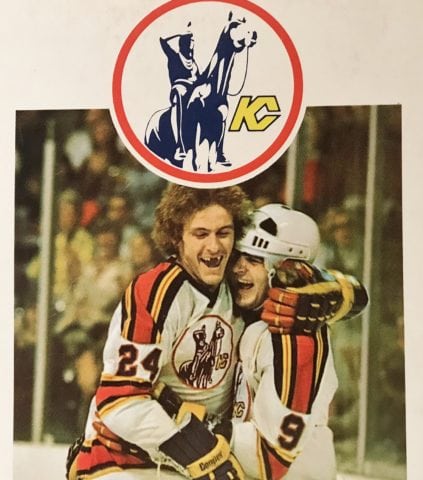
In addition to Nolet – who not only was the club’s captain but a Stanley Cup champion with the Philadelphia Flyers and was the only player to ever represent the Scouts in an NHL All-Star Game – Kansas City possessed some other worthwhile pieces.
A Dec. 15, 1974 trade saw the Scouts receive Guy Charron and Claude Houde from the Detroit Red Wings in exchange for Bart Crashley, Larry Giroux and Ted Snell. A crafty centerman, Charron became the Scouts best playmaker and would eventually have three 40-assist seasons later in his career, including one while with Kansas City.
Less than a month later the Scouts acquired netminder Denis Herron and defenseman Jean-Guy Lagace from the Pittsburgh Penguins on Jan. 10, 1975. The team gave up original Scouts goalie Michel Plasse in the process. However, Herron was a very solid netminder and became the backbone of the team for the rest of their time in Missouri.
Plenty to Be Desired for the Scouts
The Scouts had even drafted Bob Bourne with the 38th pick of the 1974 Draft. Bourne ultimately became a veteran of 964 regular season games and won four Stanley Cups with the New York Islanders. He never played a single game with the Scouts, as they traded him to the Islanders on Sept. 13, 1974 for the rights to Larry Hornung and Crashley. In retrospect, perhaps they should have held onto Bourne.
Regardless, it wasn’t as if the Scouts were without talent – they simply just did not have enough of it. The bulk of the team’s remaining components were primarily perennial minor leaguers or players beyond their prime.
A few examples:
Defenseman Hank Lehvonen played all of four games during the Scouts first campaign – the only games of his NHL career – amidst a total of six seasons in the IHL. Lehvonen would finish out his career with four seasons more over in Finland.
31-year-old defenseman Brent Hughes played his final NHL season as an original Scout, but then played his twilight years in the WHA, AHL, and CHL. This was after Hughes had already been an original member of the Los Angeles Kings and played a total of seven NHL seasons before Kansas City took him in the 1974 Expansion Draft.
Center Lynn Powis had been grabbed from the Chicago Blackhawks, and played 73 games for the Scouts in 1974-75. However, Powis would play in three different leagues during the 1975-76 season – none of which were the NHL – before wrapping up his career in the WHA and the lower leagues of Germany.
Butch Deadmarsh, Norm Dube, Robin Burns, Dennis Patterson, Peter McDuffe, and many other Scouts all had similarly short-lived NHL careers after they suited up for Kansas City in 1974-75.
The only way that the Scouts were going to find success was through the Entry Draft. They desperately needed to continue acquiring young prospects who could be combined with Paiement, Herron, Charron and the like. The selections they ultimately would make in 1975 just did not cut it.
These are the players that the Scouts ended up selecting:
Barry Dean (First Round, 2nd Overall)
Garnering the nickname of “Mean” Barry Dean, the Scouts’ top choice in 1975 ended up being a miss despite a superb junior playing career. Dean was a product of the Western Canada Hockey League (WCHL) – the precursor to today’s WHL Major Junior hockey league. Playing for the Medicine Hat Tigers, he scored 271 points (88 goals, 183 assists) in 224 games.
Dean also put up sizable junior penalty minute totals of 46, 208, 213, and 159 in his four seasons with Medicine Hat. Given his decent size of 6-foot-1 and 195 pounds, adding the “Mean” to his name seemed most fitting.
Part of the trouble was that the WHA’s Edmonton Oilers had also drafted Dean that same year, just weeks prior to the Scouts doing so. In June of 1975 the Oilers traded Dean to the Phoenix Roadrunners in exchange for Phoenix’s first and third round selections for the 1976 WHA Draft.
Dean very likely would have been in the Scouts starting lineup for the 1975-76 season, but opted to go the route of the WHA. Unfortunately, his scoring touch from junior did not carry over to the professional level. In his rookie season with the Roadrunners, Dean scored just nine goals and 25 assists for 34 points in 71 games – not even in Phoenix’s top-10 for scoring that year.
After a disappointing season with the Roadrunners, Dean’s rights were transferred over to the Colorado Rockies after the Scouts had relocated in June of 1976. He would join the franchise for the 1976-77 season but with marginally better offensive success – 14 goals and 25 assists in 79 games with the Rockies.
After just one season playing with the club that drafted him, Dean was shipped to the Philadelphia Flyers on Aug. 5, 1977 in exchange for defenseman Mark Suzor. Dean played parts of two NHL seasons with the the Flyers, before finishing out his career with three seasons in the minors.
Dean ultimately played 165 NHL regular season games. Of the 16 first-rounders selected after him, 12 of them had longer NHL careers.
Don Cairns (Second Round, 20th Overall)
Left wing Don Cairns was selected from the WCHL’s Victoria Cougars. He would end up being one of just three players that Kansas City took in 1975 that would actually play in a Scouts uniform.
Cairns was only 5-foot-9 but weighed just shy of 200 pounds. He scored 32 goals and 37 assists in 68 games during his lone season of junior hockey.
Upon being drafted, Cairns would make the jump to the professional level. He would split the 1975-76 season between three different teams and three different leagues – the AHL’s Springfield Indians, the IHL’s Port Huron Flags and in the NHL with the Scouts. Cairns helped the Flags to reach the Turner Cup Final where they would lose in three straight games to the Dayton Gems.
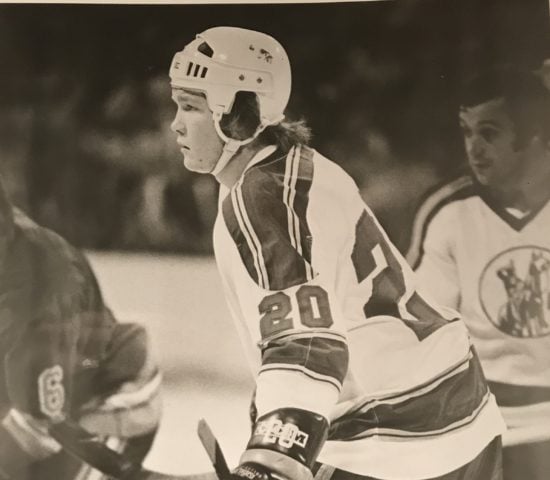
More important to our look of things, Cairns would play his first NHL game on Jan. 14, 1976 after a midseason call-up to Kansas City. Cairns and the Scouts would be blown out of the water 8-3 by the Detroit Red Wings. He would play six more games with the team between January and February – all of them being Scouts’ losses except for a 4-4 tie with the Pittsburgh Penguins on Jan. 31. Cairns was kept pointless in all seven games.
His NHL career lasted two more games after that. Cairns would make appearances on Nov. 5. and 7, 1976 as a member of the Rockies, earning a lone assist.
After a nine-game stint in 1977-78 with the CHL’s Phoenix Roadrunners, Cairns called it a career.
Neil Lyseng (Third Round, 38th Overall)
Neil Lyseng never played a game in the NHL and had only a very brief professional hockey career. The native of Calgary, Alberta, Canada had played junior hockey for the WCHL’s Kamloops Chiefs.
Between 1973-74 and 1974-75, Lyseng earned himself 339 penalty minutes in only 112 games for the Chiefs. Even though he spent a sizable amount of time in the box, he still scored 26 goals and 65 assists for 91 points in 69 games during 1974-75. That same Kamloops team also included future NHLers Reg Kerr, Brad Gassoff, Barry Melrose, and the player who would become the Scouts’ fifth-round pick in 1975.
Though leaner at 173 pounds, Lyseng was also 6-foot-2. Combining good size, toughness and somewhat of a scoring touch, he appeared lucrative to Kansas City.
Unfortunately, it did not pan out that way.
Lyseng spent the entire 1975-76 season in the CHL with the Tucson Mavericks. He would do one more in 1976-77 with the Oklahoma City Blazers. After that, Lyseng was out of hockey.
Ron Delorme (Fourth Round, 56th Overall)
Ron Delorme had the longest NHL career of the entire Scouts’ 1975 draft class, but he never played a game for Kansas City. Similar to Barry Dean, Delorme was also selected in the WHA’s draft that same year by the Denver Spurs.
Nicknamed “Chief”, Delorme had played his WCHL junior hockey with the Lethbridge Broncos. Standing 6-foot-2 and 185 pounds, he could scrap but also had some offensive skills around the net. Delorme would eventually become an NHL 20-goal scorer later in his career.
Delorme opted to played in the WHA for the Spurs for his rookie 1975-76 season. That opportunity would be extremely short-lived as the team relocated to Ottawa partway through the season to become the Civics but then folded entirely after playing seven games in their new city.
Likely disenfranchised by such a tumultuous first season, Delorme found his way to the NHL and joined the Rockies for the 1976-77 campaign. After some appearances in the minors that season, he eventually became a full-time NHLer. Delorme would play seven full seasons after his first with the Rockies, plus a partial eighth season in 1984-85.
In total, he played five seasons for the Rockies and four with the Vancouver Canucks. Delorme’s stay in Vancouver saw him make a run with the team to the Stanley Cup Final for the 1981-82 season where they eventually lost to the New York Islanders.
Though he was never a Kansas City Scout, Delorme played 524 NHL regular season games. He scored 83 goals and 83 assists for 166 points. Additionally, he earned 667 penalty minutes.
Terry McDonald (Fifth Round, 74th Overall)
Like Lyseng, Terry McDonald was a junior product of the Kamloops Chiefs. A left-handed defenseman, he potted 32 goals and 37 assists during the 1974-75 WCHL season to total 69 points in 66 games. McDonald’s ability to score from the back end made him a blueliner worth considering.
Unlike any of the other players that the Scouts took in 1975, McDonald made the immediate jump to the NHL. He would be in the lineup for Kansas City’s first seven games of the 1975-76 season.
Though McDonald was just 20 years old at the time, the Scouts may have benefited if they had kept him in the lineup for the entire season. The team would earn a 1-1 tie with the New York Islanders on Oct. 8, 1975 for their first game of the season and the first NHL game of McDonald’s career. McDonald would record his first (and only) NHL point in a 4-2 Scouts’ home victory over the Vancouver Canucks.
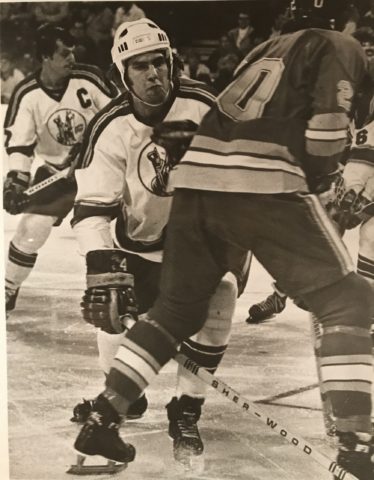
The Kansas City Scouts went 3-3-1 through those first seven games. However, in what was perhaps a move to further develop their young defender, the Scouts would only insert him into the lineup for one more game all season – a pitiful 10-0 loss to the Philadelphia Flyers on Nov. 2, 1975.
McDonald split the remainder of the 1975-76 with Kansas City’s affiliates, the Flags and the Indians. He would never reemerge in the NHL after that.
What is a bit difficult to fathom is that McDonald never received another crack at the NHL. He played three more professional seasons after 1975-76 split between the AHL, IHL, CHL, and PHL, and never scored less than 20 goals in a season. In fact, McDonald averaged more than 25 goals in those remaining three campaigns, and that was as a defenseman.
It makes one think that if he had been given more of a chance, McDonald might have caught on with the NHL. As it stands, he was out of professional hockey at the conclusion of the 1978-79 season.
Eric Sanderson (Sixth Round, 92nd Overall)
Winger Eric Sanderson was a big man even by today’s standards. Standing at 6-foot-5 and 220 pounds, he was an absolute behemoth for 1970s hockey. In an obvious attempt to garner size and physicality, the Scouts used a sixth round selection to draft Sanderson.
This particular selection could have been a “diamond in the rough” for the Scouts. Kudos to them for at least trying.
Like so many of the Scouts’ other selections in this draft, Sanderson came from the WCHL. He initially began his junior career with the New Westminster Bruins in 1973-74 where one of his teammates was longtime New York Rangers defenseman Ron Greschner. In Sanderson’s first season for New Westminster, he scored just eight goals in 62 games. However, he readily accumulated 212 penalty minutes.
Where he eventually became a player worth noting was during his sophomore WCHL season. Sanderson went from the Bruins to the Victoria Cougars. After only a goal and four assists through 14 games in New Westminster, he suddenly opened up for 18 goals and 20 assists for 38 points in 47 games as a Cougar.
Easier to see why he was a player worth considering, especially with his size to boot.
Unfortunately, Sanderson would never play a game for Kansas City. After being drafted he played only the 1975-76 season in the NAHL for the Mohawk Valley Comets and the 1978-79 season for the IHL’s Muskegon Mohawks. Just two seasons of pro hockey amounting to a mere 38 games in total.
Bill Oleschuk (Seventh Round, 110th Overall)
Bill Oleschuk was the only goaltender selected by the Scouts in 1975, and may have been their best prospect of the nine players chosen. At 6-foot-3 and 200 pounds, he was very large for a goaltender by 1970s hockey standards. Kansas City chose him from the WCHL’s Saskatoon Blades.
In retrospect, the Scouts should have utilized the 20-year-old Oleschuk more than what they did. Herron was a very strong goaltender most assuredly, and Oleschuk was a very tender age at the time, but it would be hard to find a goalie with a better NHL debut than the lone game that he pitched for Scouts.
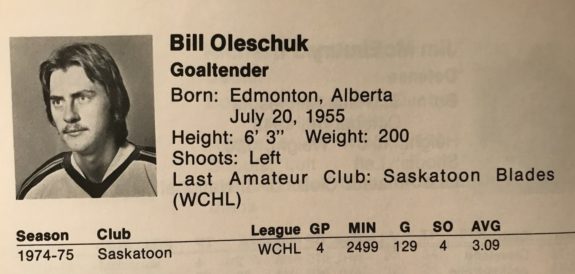
Having spent the bulk of the 1975-76 season in Port Huron, Oleschuk was called upon to man the Kansas City net in California in a Jan. 23, 1976 game against the Seals. Even though California won the game 4-1, the rookie Scouts goalie stood on his head. Oleschuk turned away 48 of the 52 shots that he faced in the game and came away with a .923 save percentage.
This would be his only NHL game as a Scout.
Oleschuk remained with the franchise for the rest of the decade and on into the 1980s. He would end up playing 54 games with the Rockies across three seasons where he made NHL appearances. Oleschuk finished his NHL career with a record of 7-28-10 to go with a 3.98 goals-against average and a .872 SV%.
Oleschuk ended his professional career after playing a single game during the 1983-84 IHL season with the Fort Wayne Comets.
Joe Baker (Eighth Round, 128th Overall)
Defenseman Joe Baker played hockey at the University of Minnesota during a time when it was quite rare for American college players to be considered by NHL teams. Under the tutelage of “Miracle on Ice” head coach Herb Brooks for four seasons, Baker helped the Golden Gophers win the 1979 NCAA Championship. A senior at the time, the rugged defenseman scored Minnesota’s third goal in the championship game of their 4-3 win over the University of North Dakota.
The sizable blueliner stood 6-foot-3 and 200 pounds, and was suited more towards the stay-at-home game. It was Baker’s 1974-75 freshman season at Minnesota that garnered professional notice, even though he had been drafted while still in high school by the WHA’s Minnsota Fighting Saints. Baker was a native of White Bear Lake, Minnesota, so it was easier for the Saints to find talent right in their own backyard.
Sticking to gaining an education, Baker played 31 games for the Golden Gophers as a freshman. He scored a goal and four assists while picking up 50 penalty minutes during that time.
Subsequently, the Scouts opted to select the college kid at number 128. It would matter not, as Baker would never play a game of professional hockey during his career. While he would not see action for the 1975-76 season with the Golden Gophers, he would return to playing for Brooks from 1976-77 through 1978-79.
In total, Joe Baker played 106 NCAA games. He scored six goals and 28 assists, while compiling 153 penalty minutes.
Scott Williams (Ninth Round, 145th Overall)
The last selection that the Scouts made in 1975 was Scott Williams whom they took in the ninth round. As was the same for all but one of their other picks, Williams came out of the WCHL. He played left wing for the Flin Flon Bombers – the former junior team of Hockey Hall of Famer Bobby Clarke.
What prompted the Scouts to select Williams was his 1974-75 performance for the Bombers, as his other two seasons in the WCHL were rather short. Playing in 70 games that particular season, he scored 23 goals and 49 assists for 72 points to go along with 110 penalty minutes. Williams’ other two seasons for the Bombers consisted of just 55 and 34 games.
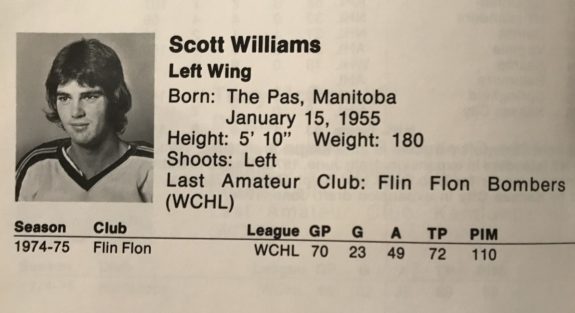
In fact, Williams remained with Flin Flon after being drafted in 1975 as opposed to going pro. In 34 games for the 1975-76 season he scored nine goals and 15 assists for 24 points.
Williams was briefly tied to the SWHL’s Amarillo Wranglers/Lone Stars for the 1976-77 season, but otherwise would not go on to have a professional hockey career.
Afterthoughts…
One has to think that the Kansas City Scouts put too many eggs into one basket. Eight of their nine selections came from the WCHL, and it may have behooved them to have scouted talent further across the country if not more globally as European players were just starting to come to North America.
Of the nine players that the Scouts drafted in 1975, only four attended the team’s 1975-76 training camp – Oleschuk, Williams, McDonald and Cairns. Of those four, all but Williams would suit up in a Scouts uniform during the regular season but amounted to a mere 16 games combined.
Enjoy more great hockey history and ‘Best of’ posts in the THW Archives